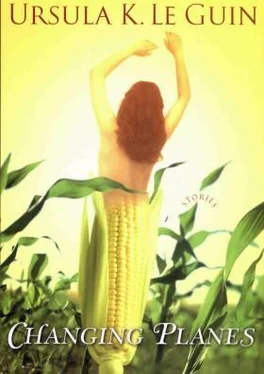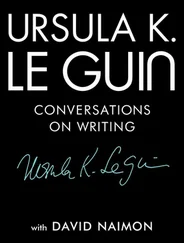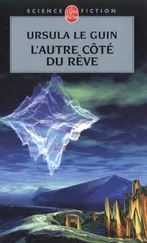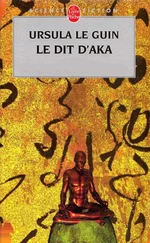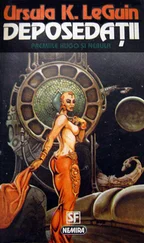Esmo So Mu described his world: hundreds of islands, many with a population of only a family or two, scattered out over the ocean “forever.” People traveled from island to island in catamarans. “Everybody go visit all the time,” he said.
The Great Joy Corporation had concentrated population in one archipelago and forbidden sailing in or out of that area. “Burn boats,” Esmo So Mu said briefly.
He had been born on an island south of the Holiday Islands and was now living there again. “Lots more money if I stay to work at the hotel,” he said, “but I don’t care.” I asked him to tell me about his home. “Oh,” he said, and laughed again. “You know what? In my home there’s no holidays! Because we are so lazy! We work one, two hours, in the gardens, then we don’t work. We play, we play with the children. We go sail. We fish. We swim. We sleep. We cook. We eat. We sleep. Why do we want a holiday?”
But Cousin Sulie was disappointed to find that the management has changed. “I don’t expect I’ll go back this August,” she told me rather sadly, when I called to wish her a happy birthday. “It just doesn’t seem like it would be like Christmas if it was a different nationality. Do you think?”
PEOPLE WHO SLEEP ONLY two or three hours in the twenty-four are always geniuses. The ones you hear about, anyway. Never mind if the ones you don’t hear about are dolts. Insomnia is genius. It must be. Think of all the work you could do the thoughts you could think, the books you could read, the love you could make, while the dull clods lie snoring.
On the plane of the Orichi, which is in many ways very similar to ours, there are people who don’t sleep at all.
A group of scientists in the Orichi nation of Hy Brisal became convinced that sleep was a vestigial behavior pattern appropriate to lower mammals but not to sapient humans. Sleep might serve to keep vulnerable simians quiet and out of harm’s way at night, but is as irrelevant to civilised life as hibernation would be. Worse, it is an impediment to intelligence -- a recurrent damper on the brain. By interrupting the brain’s ongoing functions every night, by grossly interfering with coherent thought, sleep prevents the human mind from attaining its maximum potential. Sleep makes us stupid, was the motto of the Orichi scientists.
Their government, fearing invasion from the rival nation of Nuum, encouraged any experimentation that might give Hy Brisal the edge in weaponry or brainpower. So, well funded, working with brilliant genetic engineers, and provided with ten patriotic pairs of fertile volunteers, all housed in a closed-gate compound, these scientists began a program, nicknamed Su-persmarts by the national news net, which eagerly supported it. And in four years the first entirely sleepless babies were born. (Millions of bleary-eyed young parents might dispute that statement; but the usual baby does go to sleep, after all, just about the time its parents have to get up.)
The first Supersmart babies, however, died. Some died in their first weeks, some after several months. They cried day and night until they wasted away into silence and death.
The scientists decided that infant sleep is an extension of the fetal development process that cannot safely be bypassed.
Hy Brisal and Nuum were in a particularly confrontational phase. Rumor had it that Nuum was working on an airborne germ that would sterilise all Hy Brisalian males. Popular support for the Supersmarts program had been shaken by the loss of the infants, but the government did not waver; they sent the genetic engineers back to the drawing board and asked for a new set of volunteers. Twenty-two patriotic couples signed up on the first day. In less than two years they began to produce the new generation of Supersmarts.
The programming was delicate and accurate. The new-borns would sleep as much as ordinary infants to begin with, but would gradually begin to stay awake for longer and longer periods, until by the age of four they were expected to do without sleep altogether.
And so they did. They did not waste away; they thrived. They were fine, healthy babies, all twenty-two of them. They stared up at their mothers and smiled. They kicked and cooed and sucked and crawled and did what babies do, including sleep. They were bright, because much attention was paid to them and their learning environment was rich, but they were not geniuses, yet. They learned what babies learn, including googoo and gaga, and then mama and papa, and NO, and the rest of the toddler vocabulary, at only slightly better than the average rate. Radical acceleration of learning and increase in active intelligence would come as they began staying awake.
By the time they were two, most of them were sleeping less than six hours a night. There was some natural variation in what the directors of the program called their asomnic development. The prizewinner was Baby Ha Dab, who gave up naps at ten months, and at twenty-six months was sleeping only two or three hours a night.
For several months Ha Dab, a pretty little fellow with big eyes and silvery, curly hair, was the darling of the Hy Brisalian media. He was on everybody’s homescreen—”Smartsyboy.” Here was Ha Dab lurching cheerily across a room to greet the Scientist General, Doctor Master Professor Uy Tug, author of Asomnia: The Answer, who stooped with a pinched though genuine smile to shake his tiny hand. Here was Ha Dab rolling in the grass with the blapdog puppy presented to him by the Supreme Pinnacular of Hy Brisal. Here was Ha Dab cuddling down in his little bed as if to sleep, thumb in mouth, but popping up again bright-eyed to mug at the cam man. Then Smartsyboy faded from the net, as all fads fade. For over a year little was heard about the Supersmarts program.
The Hy-Brisalian Highly Intellectual Net Locus then ran a noninteractive informational video which—carefully—raised some questions concerning the validity of asomnist theory and the supersmartness of the Supersmarts test children. The most telling part of the presentation was a brief scene of Ha Dab, now three and a half and fully asomnic, playing with his blap-dog. They were both charming little creatures, having a wonderful time roughhousing in the compound park, but it was rather troubling to see that the naked child followed the dog around instead of the dog following the child. Ha Dab also seemed curiously indifferent to the presence of strangers. When asked questions, he sometimes ignored the speaker and sometimes responded at random, as if neither speech nor human relationship meant much to him. Asked “Are you in school now?,” he wandered off a few steps and squatted down right before the cameras to defecate. There seemed to be nothing defiant about his action. It was purely shameless.
Another child shown in the presentation, however, Ra Gna, a delicate girl of nearly four who had been designated as “slow to develop” because she was still sleeping four hours a night, responded with adorable verve to the reporters, telling them that she liked school because there were micoscopes wif wiggly fings inside of them, and that she could read her affabet book nearly. Ra Gna, however, did not become the next media darling. The Supersmarts program refused to allow any more cam men on the premises for over two years—until public curiosity and media pressure became too strong for them to withstand.

At this point Dr. Mr. Prof. Uy Tug announced that the Asomnia Test was successful. None of the twenty-two children, now just under four to just over six, was sleeping more than half an hour a night, and all were in excellent health. As for their intellectual development, he explained that since it was of course not proceeding as that of hypersomnic children did, it could not be measured by the same standards. There was, however, no possible doubt of their very high intelligence.
Читать дальше
